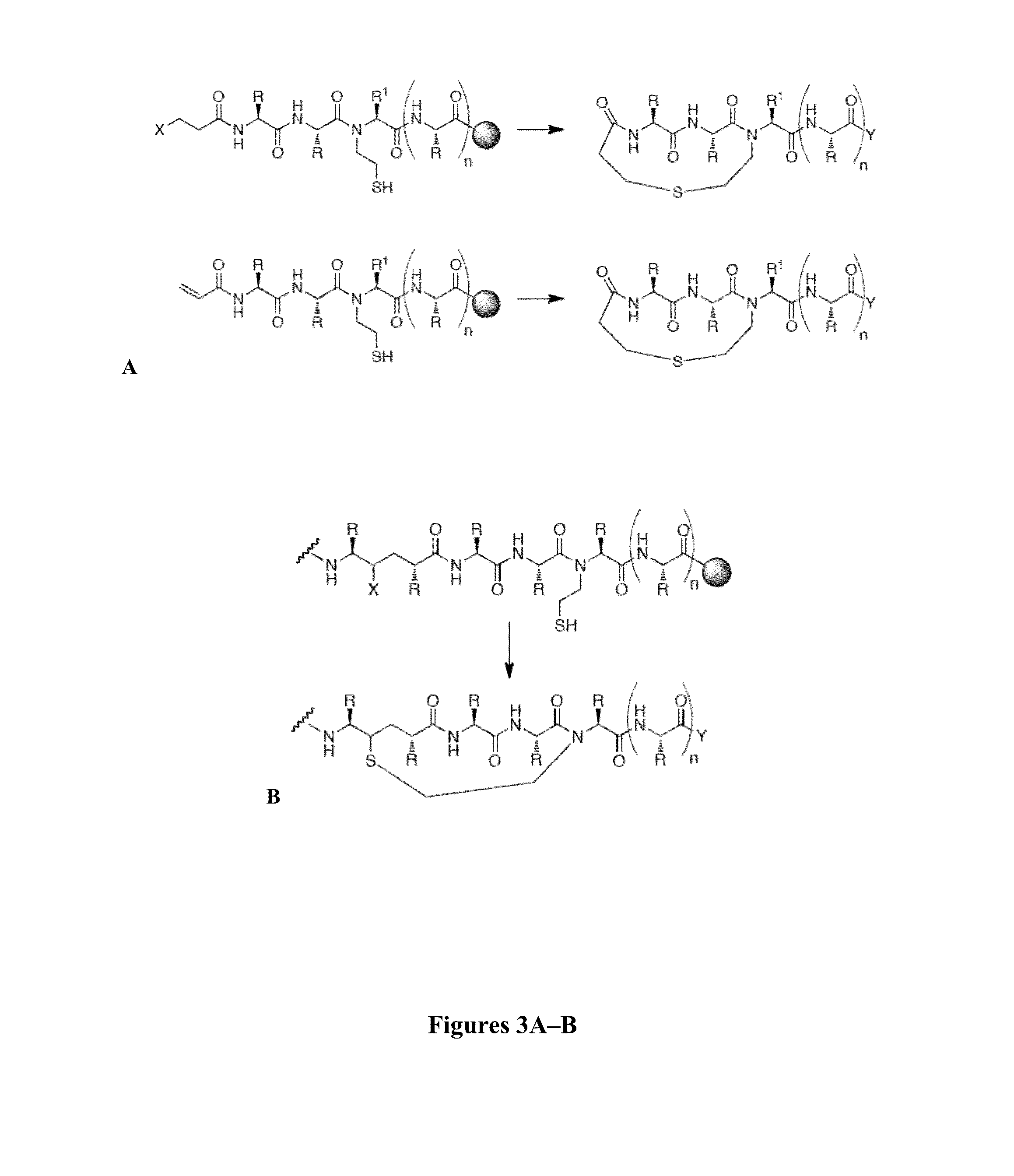Thioether-, ether-, and alkylamine-linked hydrogen bond surrogate peptidomimetics
a hydrogen bond and surrogate technology, applied in the direction of peptides, immunoglobulins, peptide/protein ingredients, etc., can solve the problems of restricting the use of hbs helices, affecting the purification efficiency of product mixtures, and blocking solvent-exposed surfaces of targets
- Summary
- Abstract
- Description
- Claims
- Application Information
AI Technical Summary
Benefits of technology
Problems solved by technology
Method used
Image
Examples
example 1
Synthesis of teHBS 1
[0167]Thioether-derived hydrogen bond surrogate peptidomimetic teHBS 1 was prepared according to Scheme 6, as described in Examples 2-11.
example 2
General Materials and Methods
[0168]Commercial-grade reagents and solvents were used without further purification except as indicated. All Fmoc amino acids, peptide synthesis reagents, and Rink Amide MBHA resin were obtained from Novabiochem (San Diego, USA). All other reagents were obtained from Sigma-Aldrich (St. Louis, USA). Reversed-phase HPLC experiments were conducted with 4.6×150 mm (analytical scale) or 21.4×150 mm (preparative scale) Waters C18 Sunfire columns using a Beckman Coulter HPLC equipped with a System Gold 168 Diode array detector. The typical flow rates for analytical and preparative HPLC were 1 mL / min and 8 mL / min, respectively. In all cases, 0.1% aqueous trifluoroacetic acid and acetonitrile buffers were used. Proton and carbon NMR spectra of monomers were obtained on a Bruker AVANCE 400 MHz spectrometer. Proton NMR spectra of HBS peptides were recorded on a Bruker AVANCE 500 MHz spectrometer. High-resolution mass spectra (HRMS) were obtained on a LC / MSD TOF (Ag...
example 3
Synthesis of S-(4-Methoxytrityl)-2-aminoethanethiol
[0169]S-(4-methoxytrityl)-2-aminoethanethiol (“S1”(Riddoch et al., Bioconjugate Chem. 17:226-35 (2006))) was synthesized as follows. Cysteamine hydrochloride (1.75 g, 16.2 mmol) and 4-methoxytrityl chloride (5 g, 16 2 mmol) were dissolved in a mixture of DMF (25 mL) and dichloromethane (25 mL) and stirred at room temperature under an atmosphere of argon for 1 hour. The reaction mixture was concentrated in vacuo and diluted with water (150 mL) before extraction with diethyl ether (3×50 mL). The organic layers were combined, washed with brine (100 mL), dried over anhydrous magnesium sulfate, and evaporated to dryness to afford a colorless oil (5.5 g, 15.7 mmol, 97%). 1H NMR (400 MHz; CDCl3) δ 2.26 (2H, t, J 6.6 Hz), 2.53 (2H, t, J 6.6 Hz), 3.70 (3H, s), 6.72 (4H, m), 7.11 (1H, m), 7.16-7.25 (7H, m), 7.30-7.34 (2H, m). 13C NMR (100 MHz; CDCl3) δ 36.24, 41.09, 55.23, 65.62, 113.11, 126.56, 127.85, 129.41, 130.69, 137.30, 145.53, 158.06....
PUM
| Property | Measurement | Unit |
|---|---|---|
| Cell death | aaaaa | aaaaa |
| Secondary structure | aaaaa | aaaaa |
| Hydrogen bond | aaaaa | aaaaa |
Abstract
Description
Claims
Application Information
 Login to View More
Login to View More - R&D
- Intellectual Property
- Life Sciences
- Materials
- Tech Scout
- Unparalleled Data Quality
- Higher Quality Content
- 60% Fewer Hallucinations
Browse by: Latest US Patents, China's latest patents, Technical Efficacy Thesaurus, Application Domain, Technology Topic, Popular Technical Reports.
© 2025 PatSnap. All rights reserved.Legal|Privacy policy|Modern Slavery Act Transparency Statement|Sitemap|About US| Contact US: help@patsnap.com



